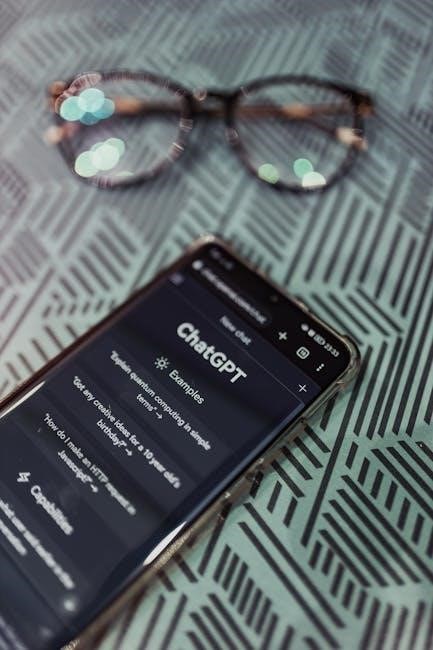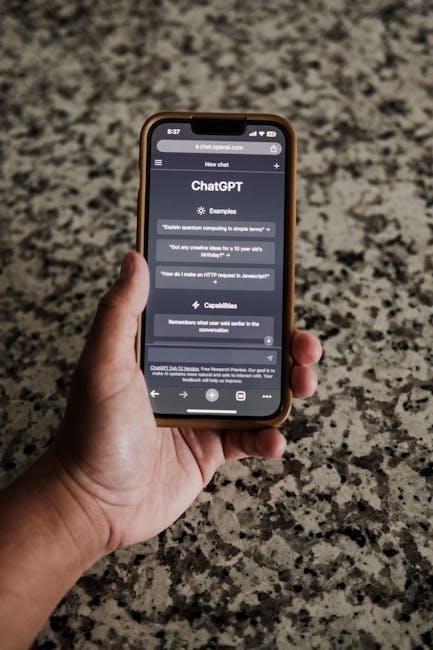The Ontario Assistive Devices Program (ADP) provides financial assistance to Ontario residents with long-term physical disabilities, helping them access essential devices for daily living and independence.
Overview of the ADP
The Ontario Assistive Devices Program (ADP) is designed to help individuals with long-term physical disabilities access essential devices for daily living. It provides financial assistance for equipment like wheelchairs, hearing aids, and other customized devices. Eligibility is based on specific criteria, and applications must be completed with the help of authorized healthcare professionals. The program aims to enhance independence and quality of life by making assistive devices more affordable. It is a vital resource for Ontario residents needing support for mobility, communication, and other critical functions.
Purpose of the ADP Application Form
The ADP application form is essential for determining eligibility and securing funding for assistive devices. It collects necessary information about the applicant’s disability, required devices, and financial circumstances. Healthcare professionals, such as audiologists and occupational therapists, must authorize the form, ensuring the requested devices are medically necessary. Once completed and submitted, the form is reviewed to assess the applicant’s needs and approve funding. This process streamlines access to critical equipment, enabling individuals to achieve greater independence and improve their quality of life.
Eligibility Criteria for the ADP
The ADP is available to Ontario residents with long-term physical disabilities requiring assistive devices for daily living. Applicants must be Canadian citizens, permanent residents, or refugees.
Who Qualifies for the Program
The ADP is designed for Ontario residents with long-term physical disabilities. To qualify, applicants must be Canadian citizens, permanent residents, or refugees. They must also have a valid OHIP card. Eligibility is determined based on the nature and duration of the disability, as well as the necessity of the assistive device. A healthcare professional’s assessment is required to confirm the need. The program supports individuals in achieving independence through essential equipment for daily living.
Required Documentation for Eligibility
To apply for the ADP, applicants must provide specific documentation. This includes a completed application form, proof of Ontario residency, and a valid OHIP card. A healthcare professional’s assessment is also required to confirm the need for the assistive device. Additional documentation, such as proof of citizenship or refugee status, may be necessary. The authorizer, typically a healthcare provider, must sign the application to validate the request; Ensuring all required documents are submitted accurately and completely is essential for a smooth approval process.
Types of Assistive Devices Covered
The ADP covers a range of devices, including wheelchairs, hearing aids, communication aids, and home modifications, to support independent living for individuals with disabilities.
Examples of Eligible Devices
The ADP covers a variety of assistive devices, including wheelchairs, scooters, hearing aids, and communication devices. Additionally, it supports home modifications like ramps and stairlifts. Customized equipment such as orthopedic devices and seating systems is also eligible. These devices are essential for individuals with long-term physical disabilities to maintain independence and improve their quality of life. The program ensures access to necessary tools that aid in daily activities and mobility.
Customized Equipment and Supplies
Customized equipment and supplies are tailored to meet specific needs, ensuring optimal functionality for individuals with unique requirements. Examples include specialized seating systems, orthopedic devices, and adaptive utensils. These items are often modified or fitted to address particular disabilities, enhancing independence and comfort. The ADP recognizes the importance of personalized solutions, providing funding for these specialized items to support daily activities and improve overall quality of life for those with long-term physical disabilities.

The Role of Healthcare Professionals
Healthcare professionals play a crucial role in assessing individual needs, recommending appropriate devices, and guiding applicants through the ADP process to ensure successful outcomes and proper device utilization.
Authorizers and Their Responsibilities
Authorizers are healthcare professionals who assess clients’ needs and complete the ADP application form. They must meet specific criteria to become authorized. Their responsibilities include evaluating eligibility, selecting appropriate devices, and ensuring accurate documentation. Authorizers act as intermediaries between applicants and the program, providing detailed justifications for device requests. They must stay updated on ADP guidelines and policies to ensure compliance. Their role is critical in facilitating access to assistive devices, enabling individuals with disabilities to achieve greater independence and quality of life through the program’s support.
Audiologists and Hearing Devices
Audiologists play a crucial role in the ADP by assessing individuals for hearing devices. They evaluate hearing loss, recommend suitable devices, and complete the application form for funding. Audiologists must be authorized by the ADP to ensure eligibility and proper device selection. Their expertise ensures that hearing aids and related devices meet the individual’s specific needs. This collaboration between audiologists and the ADP helps individuals with hearing impairments gain access to essential devices, enhancing their communication and quality of life through tailored solutions.
Steps to Complete the ADP Application Form
Obtain the form, fill it accurately with required details, and ensure healthcare professionals authorize the request. Submit the completed application for review and approval.
Obtaining the Application Form
The ADP application form can be obtained through the official Ontario government website or by contacting local health offices. Individuals can also request the form from medical professionals or service providers; Ensure the form is the most recent version to avoid processing delays. Visit the program’s official webpage or call the designated helpline for assistance. Additionally, forms may be available at community centers or rehabilitation clinics. Always verify the form’s version before starting the application process to ensure compliance with current requirements.
Filling Out the Form Accurately
Accurately completing the ADP application form is crucial for a smooth review process. Ensure all personal and medical information is correct and up-to-date. Sections for applicant details, authorizer information, and device requirements must be filled out clearly. Attach all required documentation, such as medical assessments or quotes for devices. Avoid leaving fields blank, as incomplete forms may delay processing. Use black ink and print legibly to prevent errors. If unsure about any section, consult the program’s guidelines or seek assistance from a healthcare professional or support organization.
Required Signatures and Approvals
The ADP application form requires signatures from both the applicant and their authorized healthcare professional. The applicant must sign to confirm the accuracy of the information provided. Authorizers, such as occupational therapists or audiologists, must also sign to verify the medical necessity of the requested device. Additional approvals may be needed for certain devices, ensuring compliance with program guidelines. All signatures must be original and dated to avoid processing delays. Proper approvals ensure the application is complete and eligible for review.

Submitting the Application
The completed application must be signed by both the applicant and an authorized healthcare professional before submission to the designated office for review and processing.
Methods of Submission
Completed applications can be submitted via mail, fax, or email to the designated office. Online submission through the program’s portal is also available for convenience. Ensure all required signatures and documentation are included. Applicants should retain a copy of their submission for personal records. Processing times may vary, so submitting the application well in advance is recommended. For assistance with submission, applicants can contact program support or visit the official website for detailed guidelines and resources.
Tracking the Application Status
Applicants can track their application status online through the ADP portal using their reference number. Updates are also available by contacting the program via phone or email. Processing typically takes 4-6 weeks, but may vary. Applicants are encouraged to follow up if they haven’t received a decision within this timeframe. Additionally, notifications are sent via mail or email once a decision is made, ensuring applicants stay informed throughout the process. This system aims to provide transparency and efficiency in managing applications.

Financial Assistance and Funding
The ADP offers financial assistance to Ontario residents with long-term physical disabilities, covering a portion of eligible assistive devices to enhance their independence and quality of life.
How Funding Works
The ADP provides financial assistance based on established policies, covering a portion of eligible assistive devices. Cost-sharing applies, with the program paying a percentage and the client contributing the remainder. Funding decisions are made after reviewing the application and supporting documentation; Eligible devices are approved based on medical necessity and alignment with program guidelines. Once approved, the client receives reimbursement or direct payment to the vendor. This process ensures individuals with disabilities can access essential equipment while managing costs effectively, promoting independence and improving quality of life.
Cost-Sharing and Contribution Requirements
The ADP requires cost-sharing, where clients contribute a portion of the device’s cost. The program covers a significant percentage, while the client pays the remaining amount. Contributions are based on the device’s cost and the client’s eligibility. For example, basic devices may require a smaller contribution, while complex equipment involves a higher client share. Exceptions apply for certain cases, such as children under 18, who may qualify for full funding. This cost-sharing model ensures affordability while promoting access to essential assistive devices for individuals with disabilities.
The Approval Process
The ADP approval process involves submitting the completed application form for review. The program assesses eligibility and required documentation to determine funding approval, typically within several weeks.
Review and Decision Timeline
The ADP application is typically reviewed within 2-6 weeks after submission. The timeline may vary depending on the completeness of the application and the complexity of the request. Delays can occur if additional documentation is required. Applicants can track the status of their application through the program’s online portal or by contacting the ADP directly. It is recommended to submit applications well in advance to ensure timely processing and avoid delays in receiving necessary assistive devices.
Appealing a Decision
If an application is denied, applicants have the right to appeal the decision. A written request for an internal review must be submitted within 30 days of receiving the decision letter. Applicants should provide additional documentation or clarification to support their case. The review process typically takes 4-6 weeks. If the appeal is still denied, applicants can request further review through an independent tribunal. It is important to follow the outlined procedures and timelines to ensure a fair reassessment of the application.

Additional Resources and Support
Applicants can access guides, helpline services, and online support for assistance with the ADP application form and related inquiries.
Help with Application Forms
The ADP offers various resources to assist with completing the application form, including detailed guides, video tutorials, and checklists. Applicants can access these materials online or request printed copies. Additionally, workshops and one-on-one support sessions are available through community organizations. For specific questions, the ADP helpline provides direct assistance, while the program’s website features a comprehensive FAQ section. These resources ensure applicants can navigate the process confidently and accurately.
- Downloadable guides and tutorials
- Helpline and email support
- Community-based assistance programs
Visit the official ADP website or contact local support centers for more information.
Contact Information for Assistance
For inquiries or support with the ADP application, contact the program directly. The ADP helpline is available at 1-800-268-7212 (Monday to Friday, 8:30 AM to 5:00 PM ET). You can also email ADP@ontario.ca or visit the official website at ontario.ca/adp for additional resources. Local offices across Ontario offer in-person assistance; find your nearest location on the program’s website. Representatives are ready to guide you through the application process and address any concerns.
- Helpline: 1-800-268-7212
- Email: ADP@ontario.ca
- Website: ontario.ca/adp
Reach out for personalized support to ensure a smooth application experience.

Common Challenges and Solutions
Common challenges include incomplete applications or missing signatures. Solutions involve ensuring all sections are filled accurately and submission well in advance of deadlines.
- Incomplete applications: Verify all required fields are filled.
- Missing signatures: Ensure authorizer and applicant signatures are included.
Addressing these issues promptly ensures a smoother process.
Troubleshooting Application Issues
Common issues with ADP applications include incomplete forms, missing signatures, or unclear documentation. To resolve these, ensure all sections are filled accurately and required signatures are obtained. Delays may occur if forms are not submitted correctly or if additional information is needed. Applicants should verify eligibility criteria and consult program guidelines to avoid errors. For technical difficulties, such as form downloads or submission problems, visit the program’s help page or contact support for assistance. Addressing issues promptly ensures a smoother application process and faster approval.
Understanding Denials and Rejections
Applications may be denied if they lack required documentation, incomplete forms, or if the applicant does not meet eligibility criteria, such as residency or disability requirements. If denied, applicants can appeal the decision by reviewing the reasons for rejection and submitting additional information or clarification. Understanding the denial reasons helps applicants address gaps and improve their chances of approval in future submissions. Seeking guidance from program representatives or healthcare providers can also clarify the process and requirements, ensuring a more successful application.

Future Developments in the ADP
The ADP is continuously evolving to incorporate advancements in assistive technology, enhance accessibility, and expand eligibility to better serve individuals with diverse needs and disabilities effectively.
Updates to the Program
The Ontario Assistive Devices Program (ADP) regularly updates its policies to reflect advancements in assistive technology and evolving user needs. Recent enhancements include expanded eligibility for certain devices, streamlined application processes, and improved digital submission options. The program also focuses on increasing accessibility by incorporating feedback from stakeholders and users. These updates ensure the ADP remains responsive to the diverse needs of individuals with disabilities, promoting independence and enhancing quality of life through innovative solutions and inclusive practices.
Expanding Eligibility and Device Coverage
The ADP has broadened its scope to include more individuals and devices, ensuring greater accessibility. Eligibility now extends to a wider range of disabilities, and coverage includes advanced technologies like communication devices and mobility aids. This expansion aims to address diverse needs, fostering independence and inclusion. By continuously updating its criteria, the program ensures that Ontarians have access to the latest assistive technologies, enhancing their ability to participate fully in daily life and community activities.
